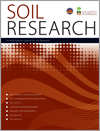SR21056Carbon (δ13C) dynamics in agroecosystems under traditional and minimum tillage systems: a review
There is pressure to minimise agriculture’s carbon footprint and increase soil organic carbon stocks using conservation tillage. We reviewed 95 research papers that examined 13C dynamics under conventional (CT) vs no-till (NT). Tillage and residue retention caused stratification in C stocks that depended on tillage depth. Highest C and stocks occurred in the surface soil under NT. When depths of soil disturbance were compared, tillage had little effect on C accumulation with the exchange of ‘old’ for ‘new’ C.
SR21056 Abstract | SR21056 Full Text | SR21056PDF (669 KB) Open Access Article





